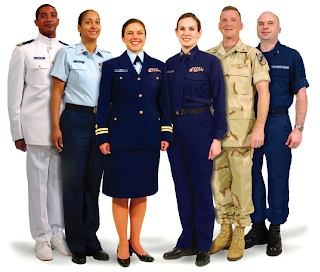UNIFORMS
Uniform
means a set of standard clothing that describe the human occupation. Uniform
plays an vital role for all human beings. Uniform is worn by member
of an organization while participating in organizations activities.
People generally wearing uniform such as army, doctor, police,
school, workplace etc.
Uniform
is Mainly used to identify people according to their work and
occupation. For example we can see doctors in white shirt, lawyers in
black coat, politician in white Kurtis etc.
Sometimes
uniforms are made mandatory by the organizations like schools, work
places like hospitals, restaurants etc. The model of these
organization require, people who are part of it to be in proper
uniform and follow the discipline of the uniform. Some organizations
which don’t have a complete dress code do have some sort of uniform
codes like a common shirt of a particular color etc.
There
are different categories of uniform such s school uniform, nursing
uniform, kitchen uniform, business uniform, waiter uniform, medical
uniform, police uniform, lawyer uniform etc. There are many reasons
that why uniform is an integral part of any organization and
lifestyle at a time.
- Industry demand:- There are certain service industries which are focused on the customer such as department store, restaurant or hospitals. So the role of uniform is very important when the customer wearing a pleasant uniform, the customer approaches them more confidently.
- Uniform as perks: In some large organizations, it is considered as an honor and a kind of perk to receive uniform. This results in considerable conservation of time and energy of the personnel, as he doesn’t have to choose again and again the clothes to be worn at the work place. Also a lot of money is saved since rarely will that personnel will be buying new clothes.
- A sense of belonging:- If the workforce wear the same cloth in the workplace then they feel the sense of commonsense and belonging.
- A feeling of equality:- Uniform brings every one to the same platform, no matter how they rich and poor.
- Mutual growth:- people who wearing uniform are ore caring about their fellows and colleagues but the growth of their peer as well.
School:-
Uniform
required almost in every school which is important for maintaining
discipline,unity. Uniforms are required in many schools. School
uniforms vary from a standard issue T-shirt to rigorous requirements
for many items of formal wear at private schools. School uniforms are
in place in many public schools as well.
 Countries
with mandatory school uniforms include Japan, India, Australia, some
schools in China, and the United Kingdom, among as many other places.
In some countries, uniform types vary from school to school, but in
the United Kingdom, many pupils between 11 and 16 of age wear a
formal jacket, tie and trousers for boys and blouse, tie and
trousers, skirt, or culottes for girls. The ties will usually be in a
set pattern for the school, and jackets will usually carry a patch on
the breast pocket with the school's name, coat of arms, and motto or
emblem. Jackets are being replaced in many schools by sweatshirts
bearing the school badge. Children in many United Kingdom state
primary schools will have a uniform jumper and/or polo shirt with the
school name and logo.
Countries
with mandatory school uniforms include Japan, India, Australia, some
schools in China, and the United Kingdom, among as many other places.
In some countries, uniform types vary from school to school, but in
the United Kingdom, many pupils between 11 and 16 of age wear a
formal jacket, tie and trousers for boys and blouse, tie and
trousers, skirt, or culottes for girls. The ties will usually be in a
set pattern for the school, and jackets will usually carry a patch on
the breast pocket with the school's name, coat of arms, and motto or
emblem. Jackets are being replaced in many schools by sweatshirts
bearing the school badge. Children in many United Kingdom state
primary schools will have a uniform jumper and/or polo shirt with the
school name and logo.
Sports:-
Most,
if not all, professional sports teams also wear
uniforms, made in the
team's distinctive colors, often in different variations for "home"
and "away" games. In the United Kingdom, especially in
soccer, the terms "kit" or "strip" (as in
'football kit') are more common.
Military
personnel or civilian officials generally wear several kinds of
uniforms:
·
Battle dress, khakis;
·
Dress uniform: worn at ceremonies, official receptions, and other
special occasions; medals are typically worn.
·
everyday work uniform, often with abbreviated forms of embellishment
(such as using duller buttons or replacing medals with ribbon bars);
Service
and work uniforms
Workers
sometimes wear uniforms or corporate clothing of one nature or
another. Workers required to wear a uniform include retailer workers,
bank and post office workers, public security and health care
workers, blue collar employees, personal trainers in health clubs,
instructors in summer camps, lifeguards, janitors, public transit
employees, towing and truck drivers, airline employees and holiday
operators, and bar, restaurant and hotel employees. The use of
uniforms by these organizations is often an effort in branding and
developing a standard corporate image but also has important effects
on the employees required to wear the uniform.


